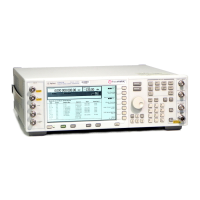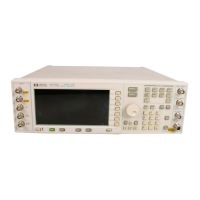130: Enter the query resp onse into a variable 'W'. Boolean
responses are always '1' for ON and '0' for OFF.
140: Print the value of the POWER:STATE on the computer
display.
150: Query the value of a discrete function (FREQ:MODE).
160: Dimension a string variable to contain the response.
170: Enter the resp onse into A$. The resp onse will b e a string
that represents the function's presentvalue.
180: Print the value of A$ on the computer display.
190: Example usage of a MIN query. This will request the
maximum value that the FREQ:CW function can be programmed
to.
200: Enter the numeric response into the variable A.
210: Print the value of A on the computer display.
220: This is comp ound query. Up to 8 parameters can be queried
from the swept signal generator at one time using this metho d. In
this example, the start and stop frequencies are in
terrogated.
230: The responses are read backinto the variables X and Y. The
order of the resp onses is the same as the order of the queries. X
will contain the START frequency and Y will contain the STOP.
240 to 260: Print the START/STOP frequencies on the display.
1-96 Getting Started Programming

